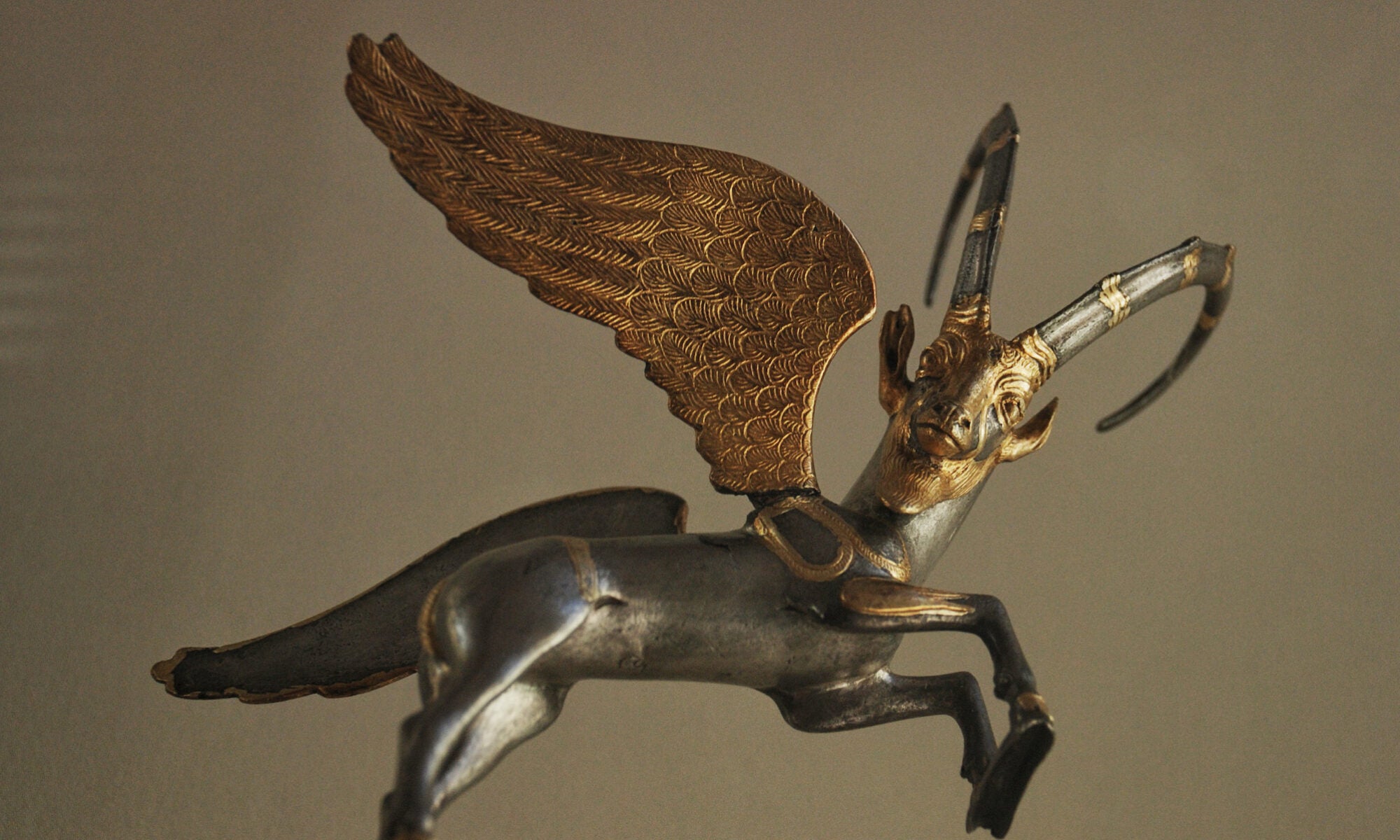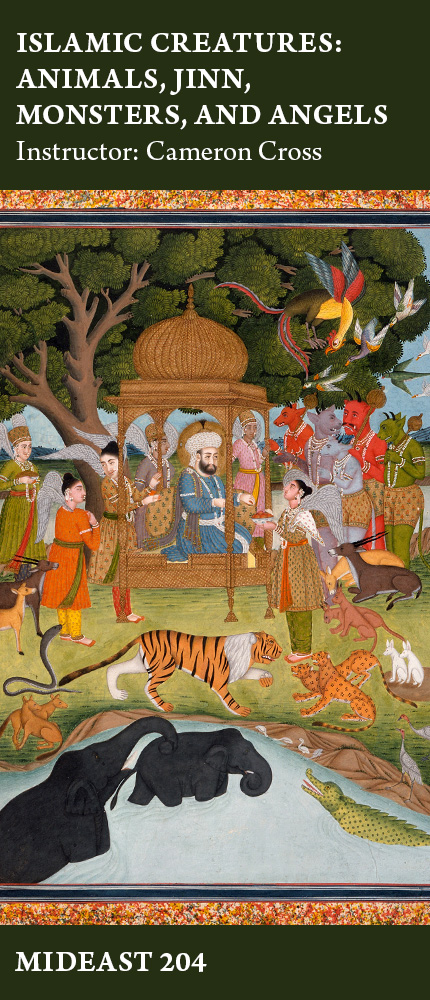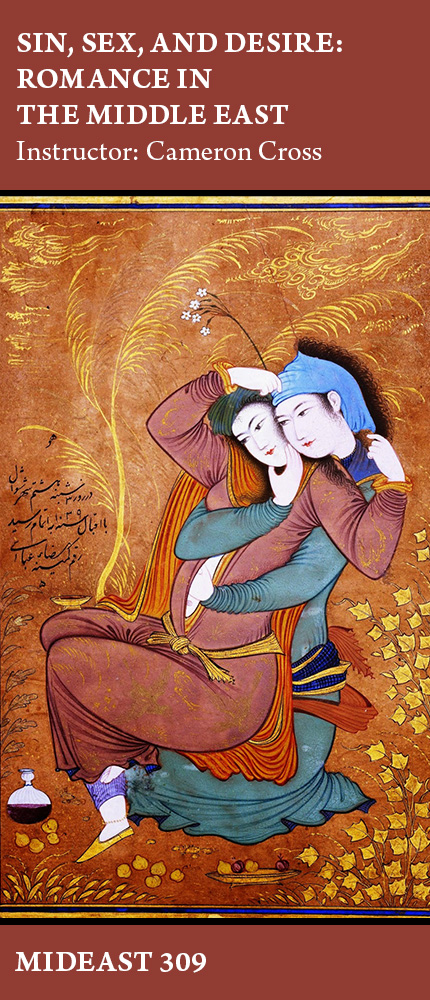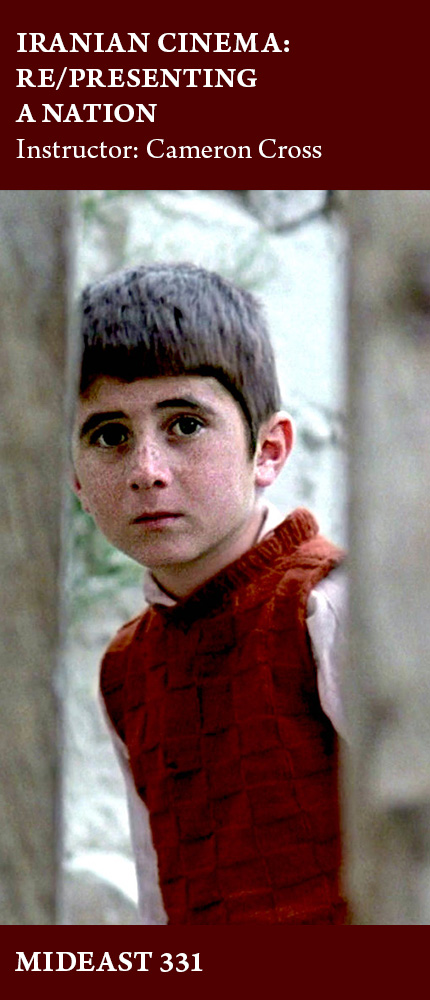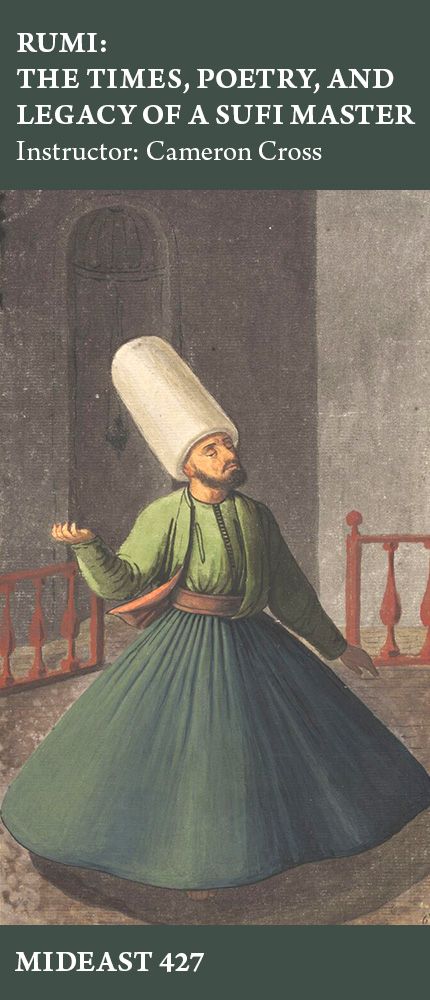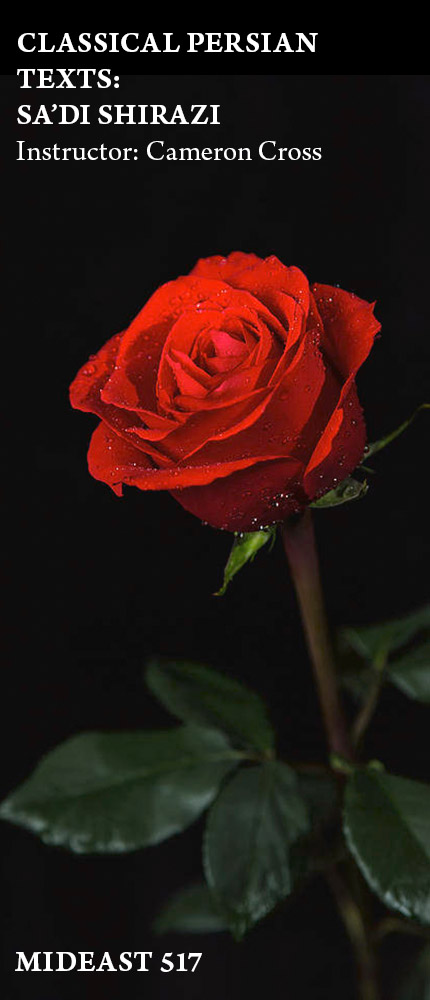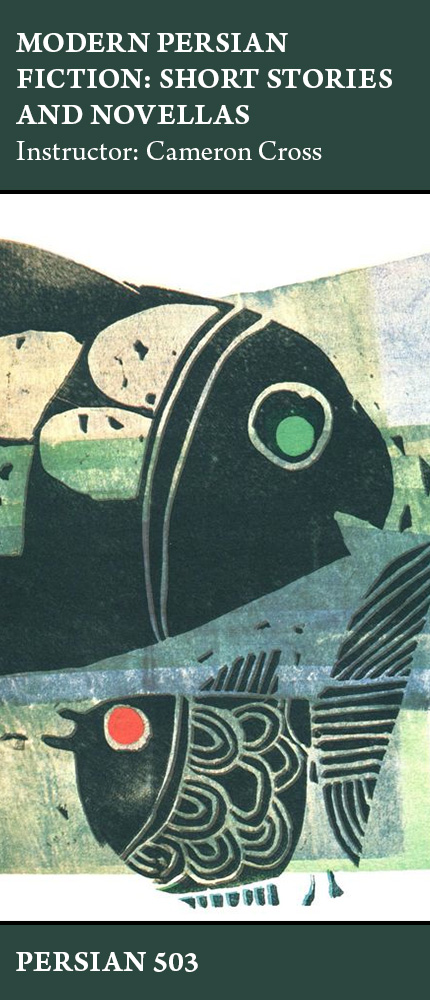One of the things I enjoy most at Michigan is teaching. Below you’ll find a catalogue of the courses I’ve developed here; click on any of the badges to see a brief course description, a recent syllabus, bibliography, and other resources. If you have any questions about any of these courses, please don’t hesitate to get in touch with me, and if you have any suggestions for new topics to add to this list, I’d love to hear them!
MIDEAST 204 – Islamic Creatures: Animals, Jinn, Monsters, and Angels
In this course, we will explore the heritage of Islamic theology, philosophy, and literature through the lens of non-human actors: animals, jinn, fairies, monsters, angels, and demons. Reading across a wide range of textual and cinematic works, spanning from scripture and poetry to epic and fantasy, allegory and philosophy, horror and satire, we will discuss how these perspectives form, and complicate, the category of human and the idea of Islam. Students taking this course can expect not only to become familiar with an array of important Islamic texts and stories, but to discover new frameworks for theorizing their own humanity.
- Recent syllabus
- Class bibliography
MIDEAST 291 – Travellers and Travelogues: Mapping the Middle East
What is the “Middle East,” anyway? Who defines it, and to whom is it a meaningful term? What other terms and concepts have people—both “inside” and “outside” the region, however we choose to define it—used to describe themselves and others? This course addresses these questions through the close-reading of maps and travelogues as primary sources. This means that we will encounter many “Middle Easts,” and many “Middle Easterners,” with dramatically different rubrics for selfing and othering than what is prevalent today; thus, at the end of this survey, students will have acquired a multi-layered, historically grounded, and critically aware range of approaches to mapping the “Middle East” that will complicate the homogeneity implied by the modern term. Selected texts will include memoirs by preachers, emperors, bureaucrats, judges, traders, diplomats, and pilgrims, featuring authors like Ibn Fadlan, Naser-e Khosrow, Ibn Battuta, Marco Polo, Evliya Çelebi, Sekandar Begum, Lady Montagu, Rifa’ah al-Tahtawi, Jane Dieulafoy, Gertrude Bell, Al-e Ahmad, and Malcolm X.
- Recent syllabus
- Class bibliography
MIDEAST 309 – Sin, Sex, and Desire: Romance in the Middle East
This class offers an introduction to Middle Eastern romance through a close reading of some of its prominent examples, with an eye for how they construct and subvert their own ideology: even as they vaunt chastity and fidelity, normative gender roles, and licit sex (typically heterosexual marriage) as ideal virtues, they simultaneously interrogate those ideals with numerous cases of betrayal, murder, castration, gender-bending, and illicit sex (incest, adultery, or same-sex relations). The role of women in society, and their agency in shaping their stories and destinies, lies at the center of this negotiation, and will be a constant focal point for us throughout the course. In this seminar class, students will develop a framework for critically unpacking contemporary notions of love through their engagement with the past, allowing them to reconsider how such seemingly universal experiences can be conditioned by society and culture, yet also to recognize the drives, emotions, and obsessions that we may know from our personal lives in people who lived and loved centuries ago and continents away.
- Recent syllabus
- Class bibliography
MIDEAST 331 – Iranian Cinema: Re/Presenting a Nation
This seminar course is an overview of the century-long history of Iranian cinema, beginning with the first films that came out of the encounter with Europe and up to the celebrated place it holds in the world today. The films are contextualized with lectures and readings that highlight critical themes in modern Iranian history, including colonialism, nationalism, race and ethnicity, the performance and politics of gender, international relations, the struggle for (self-)representation, social protest, and revolution. Students who take this course can expect to gain not only a firm grasp of the major figures and movements in Iran’s cinematic history, but also exposure to some major theoretical approaches within this field: formal analysis, genre, gender, and the gaze, the role of women behind and before the camera, the formation of modern subjectivity, political media work, postcolonial studies, hyphenation and hybridity, and the global frameworks of “(inter-)national,” “(third-)world,” and “accented” cinema.
- Recent syllabus
- Class bibliography
- List of Iranian films at U-M
MIDEAST 427 – Rumi: The Times, Poetry, and Legacy of a Sufi Master
Of all the poets in the millennium-long history of Persian literature, no figure is better known in the United States today than Jalal al-Din Rumi. Widely known as “Mawlana” (“Our Master”), Rumi is revered to this day as a guide who presents his written work — a volume of ecstatic lyrical poems, and the “Spiritual Couplets,” a sprawling collection of tales, homilies, and the occasional dirty joke — as a program of spiritual growth and self-mastery. In this class, we will situate the close study of Rumi’s oeuvre within a broad contextual framework that includes excerpts from the major Sufi poets who preceded him, examples from contemporary Jewish and Christian mystical writing, and the historical milieu of medieval Anatolia where he preached. The politics of translation, by which he is largely known in North America today, will also be a topic of conversation. By reading Rumi from these multiple perspectives — with a microscope in one hand and a wide-angle lens in the other, so to speak — we will gain not only a solid foundation in the work of one of the most popular and enduring literary figures in Islamic thought, but a broader understanding of why and how the medieval and mystical legacies continue to be highly relevant today.
- Recent syllabus
- Class bibliography
MIDEAST 434 – Shahnameh: Iranian Myth, Epic, and History
Written over a thousand years ago, the Shahnameh, or “Book of Kings,” is a repository of the historical and cultural memory of the Iranian people, weaving myth, epic, folklore, allegory, chronicle, romance, and tragedy into a grand narrative of Iran’s ancient past. Over fifteen weeks, we will read the entirety of the text in translation and discuss a wide range of topics, themes, and questions pertinent to it, such as the integration of Indo-Iranian mythology and Zoroastrian religious beliefs into an Islamic framework; competing notions of Iran as land, people, and nation; crises of justice both human and divine; intersections of animality, femininity, the demonic, and the foreign; the complex relations of kinship and kingship; story-telling and oral performance; and the interaction between individual episodes and the work’s overarching structure. Through their engagement with these topics, students can expect rigorous training in the skills of critical thinking and analytical writing, and to gain cultural fluency in a body of stories that continue to be told and retold to this day.
- Recent syllabus
- Class bibliography
MIDEAST 517 – Classical Persian Texts: Sa’di
This course is an introduction to classical Persian poetry and prose through the works of Sa’di of Shiraz (d. 1291). Sa’di is universally acknowledged as one of the giants of Persian literature; writing in a fluid and flexible idiom, he brought together lofty verse, bawdy jokes, sage advice, and blistering satire with a savvy grace famously known as “inimitable simplicity.” His Gulistan (“Rose-garden”), a collection of stories, poetry, and aphorisms, is probably the single most admired and influential work of literature in the Persian language, and served as the gateway to mastering the Persian language and to entering the world of Persianate adab — a complex of literary, social, and aesthetic values that extended from Bosnia to Bengal — for over half a millennium. By studying this central text, along with Saʿdī’s didactic and lyrical poetry, students will gain a working vocabulary and skill-set that should have them equipped to read nearly any pre-modern Persian literary text, as well as an understanding of the conventions of the ubiquitous ghazal form, familiarity with a vault of proverbs, sayings, and aphorisms that continue to be spoken to this day, and a rich picture of the Middle East in the thirteenth century.
- Recent syllabus
- Class bibliography
PERSIAN 503 – Modern Persian Poetry: The Song of Revolution
As the nineteenth century came to a close, the poets of Persia began to challenge the basic assumptions and techniques of their craft, initiating a literary movement that played a decisive role in the society and politics of modern Iran. This course offers a survey of the major figures, movements, and works of this era, spanning the long twentieth century and underscored by the revolutions of 1906 and 1979: we will encounter censorship and satire, suppression and rebellion, right-wing nationalism, the global Left, neo-Sufism, social symbolism, women’s liberation, revolutionary Islam, anti-/war poetry, and the traumas of exile. Through close readings of original texts, we will practice the analysis of poetry on formal, sonic, and semiotic levels, while additional readings in English will help us relate these works to their broader social and historical context, exploring the interplay of art and politics and its enduring consequences in the world we live in today. Along the way, we will learn the rules of Persian prosody, expand our vocabulary, consolidate our grammar, and improve our reading and speaking skills.
- Recent syllabus
- Class bibliography
PERSIAN 505 – Modern Persian Fiction: Short Stories and Novellas
The Persian short story, with native roots in the prose and verse genres of the hekayat and the romance, and in consciously adopted western models, has become—along with the novella—perhaps the premier form of modern fiction in Iran. In this intermediate-advanced Persian course, we will read selections from some of form’s most prominent practitioners, such as Jamalzadeh, Hedayat, Chubak, Daneshvar, Al-e Ahmad, Alavi, Parsipur, Ravanipur, Dowlatabadi, Golshiri, Taraghi, and Pirzad, with English translations to supplement the Persian originals. Through this survey, students will learn about the historical development of the Persian short story over the last hundred years, develop a vocabulary for reading and discussing prose works in Persian, and consider various theoretical and comparative approaches to the study of modern Persian literature. The final weeks of the semester will be “students’ choice”: having gotten a lay of the land, we will as a group select one or two short stories and/or novellas to read in depth. This way, students can leverage the class to explore issues of particular interest to them.
- Recent syllabus
- Class bibliography

